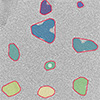| Apr 28, 2025 |
A pioneering low-dose imaging technique reveals detailed atomic structures of titanium oxyhydroxide nanoparticles, advancing next-gen materials research.
(Nanowerk News) Nanomaterials are the future of modern technology. From powering batteries to improving clean energy systems and efficient catalysts, nanomaterials are everywhere. Their unique properties, which make them stand out, often arise from the precise arrangements of their atoms. But despite their importance, the smallest building blocks of these materials have often remained hidden, which is a major limitation for analysis—especially when the materials are too sensitive to withstand the strong electron beams used in traditional imaging.
|
|
Overcoming this hurdle, a team of researchers at the Japan Advanced Institute of Science and Technology (JAIST) has now come up with a breakthrough method that promises detailed analysis without structural compromise. By combining high-resolution transmission electron microscopy (HRTEM) with a data-driven lattice correlation analysis, the team successfully mapped the three-dimensional atomic structure of titanium oxyhydroxide nanoparticles, a class of materials prized for their applications in energy devices and advanced catalysts.
|
 |
| Workflow of lattice-correlation analysis: (a) HRTEM image showing dark contrast metatitanic acid nanoparticles. (b) Detected particles color-coded by image processing. (c) Fast Fourier Transform (FFT) of the particle marked in (b). (d) Lattice correlation map with (004)/(110) and (002)/(110) spots. (e) Proposed crystal model. (f) Simulated annular dark field scanning transmission electron microscopy (STEM) of the model. (g) Annular dark field STEM of metatitanic acid nanoparticles. (Image: Yoshifumi Oshima, JAIST)
|
|
The study was led by Professor Yoshifumi Oshima from JAIST along with his teammates, including Senior Lecturer Kohei Aso, Senior Technical Specialist Koichi Higashimine, Former Senior Lecturer Masanobu Miyata from JAIST, and Dr. Hiroshi Kamio from Nippon Steel, Japan. Their findings were published in the journal Communications Chemistry (“Three-dimensional atomic-scale characterization of titanium oxyhydroxide nanoparticles by data-driven lattice correlation analysis”).
|
|
One of the most remarkable aspects of this new technique is how it protects the fragile nanomaterials during imaging. Traditional electron microscopy heavily relies on strong electron beams to generate detailed images. These beams often damage the sensitive samples (like titanium oxyhydroxides) before they can be analyzed. But the new method solves this problem by reducing electron exposure by 20 to 500 times compared to conventional techniques, delivering improved resolution without the risk of beam-induced damage.
|
|
“Controlling the crystal structures of metal oxyhydroxides is the key for their applications, but this is often limited by the difficulties of analyzing these beam-sensitive nanomaterials,” explains Senior Lecturer Aso. “But our method enables a safer approach for structural analysis, allowing researchers to understand and control their properties effectively.”
|
|
Using this approach, the team made a fascinating discovery about metatitanic acid (H2TiO3), which is a titanium-based material and a key component in various catalytic and energy applications. The analysis revealed an alternating layered structure of the metatitanic acid, which was composed of titanium dioxide (TiO2) and titanium hydroxide (Ti(OH)4). This structure was found to be very similar to anatase, a natural mineral of titanium dioxide (TiO2) with unique optical and electronic properties.
|
|
“The striking structural resemblance between metatitanic acid and anatase vividly explains why metatitanic acid is a widely favored precursor for the synthesis of the anatase phase of TiO2,” reveals Senior Lecturer Aso.
|
|
This discovery opens possibilities for designing materials with enhanced functionality for real-world uses of titanium oxyhydroxide, like improving the efficiency of chemical reactions in catalysts or boosting the performance of materials in batteries and sensors.
|
|
While the structural analysis of titanium oxyhydroxide has great potential, the implications of the research extend far beyond a single material. There are many advanced nanomaterials currently being used in today’s cutting-edge technologies that suffer from the same vulnerability to electron beam damage. The method developed at JAIST sets the stage for investigating these materials for improved outcomes and innovations in clean energy, electronics, and sustainable technologies.
|
|
In addition to expanding what’s possible in experimental research, the study aligns well with the growing role of computational research in materials science. Looking ahead, the researchers envision their lattice correlation analysis becoming an essential tool in this data-driven future, enabling smarter material design and the development of high-performance devices.
|


